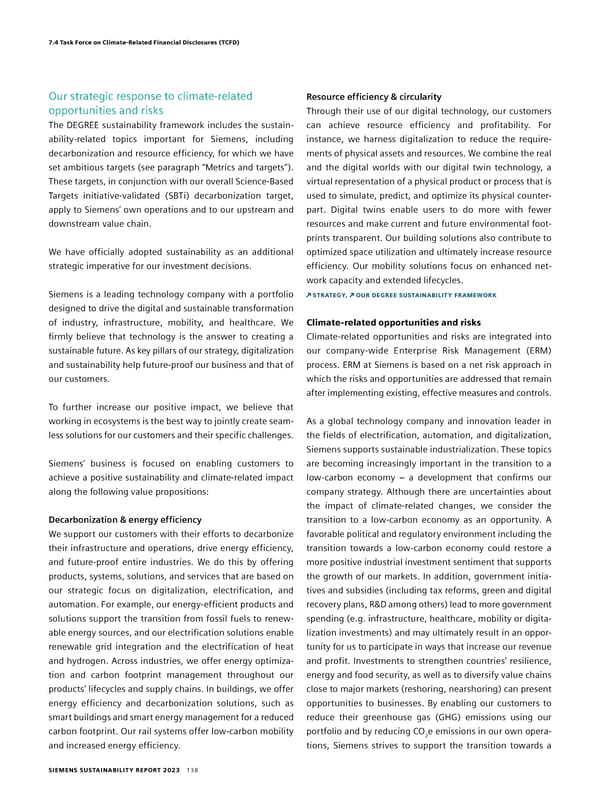7.4 Task Force on ClimateRelated Financial Disclosures (TCFD) Our strategic response to climate-related Resource efficiency & circularity opportunities and risks Through their use of our digital technology, our customers The DEGREE sustainability framework includes the sustain- can achieve resource efficiency and profitability. For ability-related topics important for Siemens, including instance, we harness digitalization to reduce the require- decarbonization and resource efficiency, for which we have ments of physical assets and resources. We combine the real set ambitious targets (see paragraph “Metrics and targets”). and the digital worlds with our digital twin technology, a These targets, in conjunction with our overall Science-Based virtual representation of a physical product or process that is Targets initiative-validated (SBTi) decarbonization target, used to simulate, predict, and optimize its physical counter- apply to Siemens’ own operations and to our upstream and part. Digital twins enable users to do more with fewer downstream value chain. resources and make current and future environmental foot- prints transparent. Our building solutions also contribute to We have officially adopted sustainability as an additional optimized space utilization and ultimately increase resource strategic imperative for our investment decisions. efficiency. Our mobility solutions focus on enhanced net- work capacity and extended lifecycles. Siemens is a leading technology company with a portfolio STRATEGY, OUR DEGREE SUSTAINABILITY FRAMEWORK designed to drive the digital and sustainable transformation of industry, infrastructure, mobility, and healthcare. We Climaterelated opportunities and risks firmly believe that technology is the answer to creating a Climate-related opportunities and risks are integrated into sustainable future. As key pillars of our strategy, digitalization our company-wide Enterprise Risk Management (ERM) and sustainability help future-proof our business and that of process. ERM at Siemens is based on a net risk approach in our customers. which the risks and opportunities are addressed that remain after implementing existing, effective measures and controls. To further increase our positive impact, we believe that working in ecosystems is the best way to jointly create seam- As a global technology company and innovation leader in less solutions for our customers and their specific challenges. the fields of electrification, automation, and digitalization, Siemens supports sustainable industrialization. These topics Siemens’ business is focused on enabling customers to are becoming increasingly important in the transition to a achieve a positive sustainability and climate-related impact low-carbon economy – a development that confirms our along the following value propositions: company strategy. Although there are uncertainties about the impact of climate-related changes, we consider the Decarbonization & energy efficiency transition to a low-carbon economy as an opportunity. A We support our customers with their efforts to decarbonize favorable political and regulatory environment including the their infrastructure and operations, drive energy efficiency, transition towards a low-carbon economy could restore a and future-proof entire industries. We do this by offering more positive industrial investment sentiment that supports products, systems, solutions, and services that are based on the growth of our markets. In addition, government initia- our strategic focus on digitalization, electrification, and tives and subsidies (including tax reforms, green and digital automation. For example, our energy-efficient products and recovery plans, R&D among others) lead to more government solutions support the transition from fossil fuels to renew- spending (e.g. infrastructure, healthcare, mobility or digita- able energy sources, and our electrification solutions enable lization investments) and may ultimately result in an oppor- renewable grid integration and the electrification of heat tunity for us to participate in ways that increase our revenue and hydrogen. Across industries, we offer energy optimiza- and profit. Investments to strengthen countries’ resilience, tion and carbon footprint management throughout our energy and food security, as well as to diversify value chains products’ lifecycles and supply chains. In buildings, we offer close to major markets (reshoring, nearshoring) can present energy efficiency and decarbonization solutions, such as opportunities to businesses. By enabling our customers to smart buildings and smart energy management for a reduced reduce their greenhouse gas (GHG) emissions using our carbon footprint. Our rail systems offer low-carbon mobility portfolio and by reducing CO e emissions in our own opera- 2 and increased energy efficiency. tions, Siemens strives to support the transition towards a SIEMENS SUSTAINABILITY REPORT 2023 138
 Sustainability Report Page 137 Page 139
Sustainability Report Page 137 Page 139